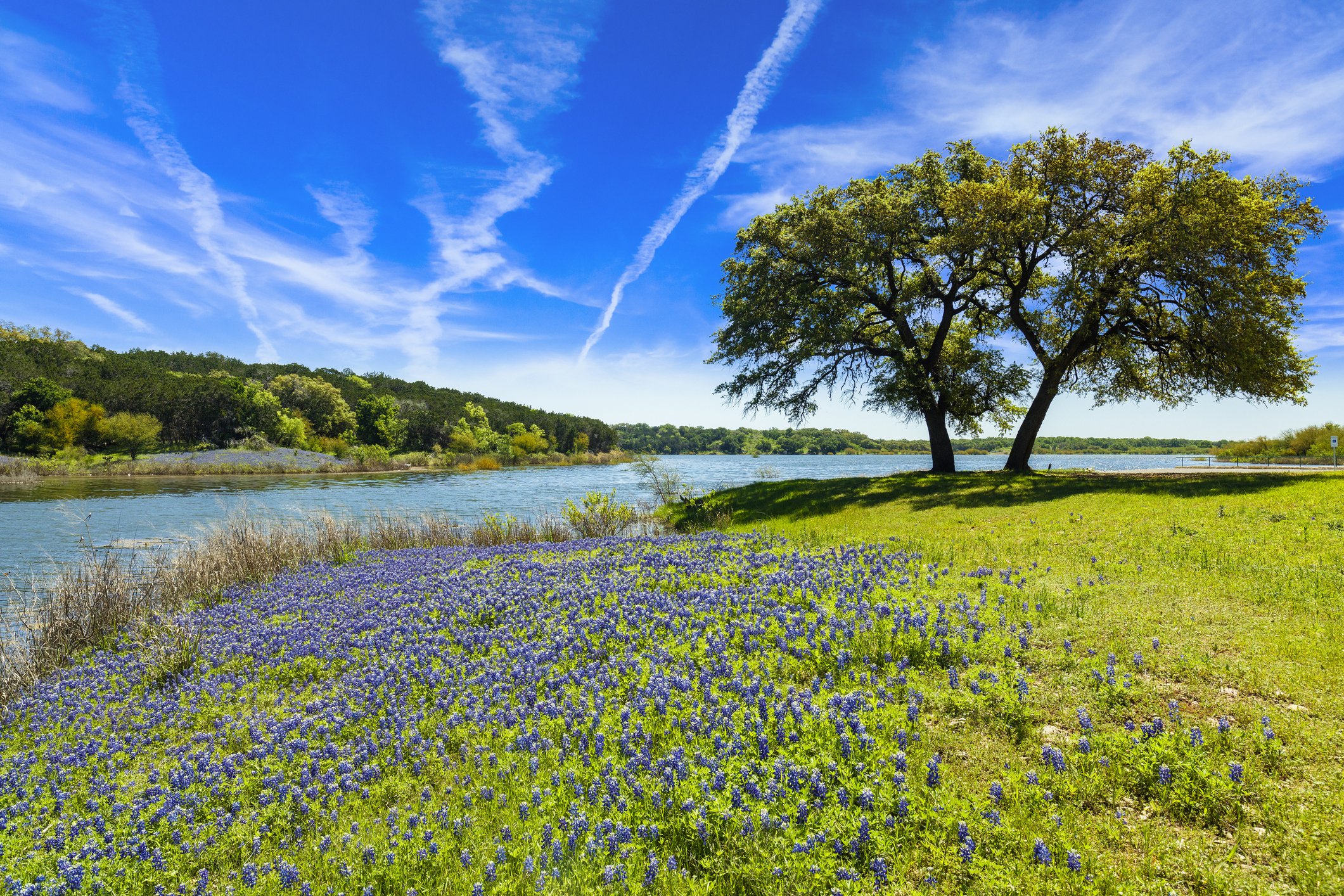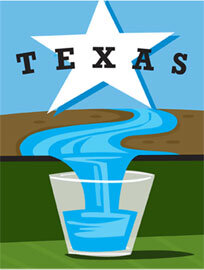
Public Water Systems
About the Source Water Protection Program
The Source Water Assessment and Protection Program (SAWPP) was created by 1996 amendments to the Safe Drinking Water Act; SWAPP is the centerpiece of the Act’s prevention focus. The program encourages local governments and water utilities to take proactive steps to protect local drinking water supplies before costly treatment enhancements are required.
The Texas Commission on Environmental Quality (TCEQ) is required to complete a source water susceptibility assessment for each public water supply (PWS) system. These assessments provide water systems with additional information regarding the susceptibility of their water supplies to 227 individual drinking water contaminants, including those that may present a threat to public health such as viruses and bacteria. After the PWS reviews the Assessment Report, the next step is to determine what measures can be implemented to decrease contaminant susceptibility, thereby enhancing and protecting the system’s source waters.
Best Management Practices (BMPs) encompass a broad range of measures targeted to prevent, reduce, or remove contaminants entering a water supply system. They include strategies, structural controls, regulations, and public education and outreach. BMPs may be implemented as a prevention method, implemented at the source of potential contamination, or implemented within water bodies once contamination has occurred. BMPs can be chosen based on a system’s needs, concerns, and budgetary constraints. Detailed guidance is available from the TCEQ’s Source Water Protection Program. Much of the material provided here is adapted from the agency’s comprehensive BMP Guidance Manual.
Incentives to Participate
Most people would agree that a vaccination to prevent illness is well worth the time, expense, and inconvenience. Similarly, local governments are using source water protection approaches to prevent drinking water supply contamination.
BMP implementation includes inherent benefits to the PWS and the customers it serves. The benefits of protecting source waters are best illustrated when compared to the costs of failing to protect these resources. It’s not always possible for all benefits and costs to be measured in dollar terms. Easily quantifiable costs of source water contamination include the costs of treatment, remediation, establishing a new source of water, litigation against responsible parties, and conducting public information campaigns. Not included are such costs to individuals as lost wages, medical bills, reduced property values, and higher water bills.
Incentives to consider in implementing a Source Water Protection Program include:
May improve Source Water Susceptibility Assessment results;
May reduce monitoring requirements offered by TCEQ;
May improve competitive standing in Texas Water Development Board Drinking Water State Revolving Fund (SRF) Intended Use Plan;
Demonstrate proactive approach and build confidence in system by including program participation in annual Consumer Confidence Report;
Avoid costs of complying with the disinfection byproducts rule;
Maintain real estate values in areas served by protected water supplies;
Minimize water-related health risks;
Avoid increased treatment costs and increased capital investment for new treatment technology;
Avoid costs of contaminated water supplies (including treatment costs, replacement costs, and damage costs); and
Increase aesthetic and recreational value.
The benefits of source water protection to communities are impressive. Many communities across the state have proven that source water protection is indeed a cost-effective approach to safeguarding their drinking water supplies. Factoring in all of the benefits, such a protection program will prove to be a true bargain.
More than 1,000 public water systems in Texas are participating in this voluntary and free program; their success stories can be replicated in your community.
For Additional Information:
Example Plan of Action
Protecting your drinking water supply from contamination can be accomplished by completing five basic steps:
Form a community planning team;
Work with the TCEQ in defining the land area to be protected;
Identify and locate PSOC;
Manage the protection area; and
Plan for the future.
-
Although the size and membership of a community planning team may differ from one community to the next, the planning team must represent all interests in your community. If there are existing groups who have worked together successfully in the past, it may be useful and convenient to build a planning team around them. Perhaps the most important component of this first step is the selection of a leader who can keep the planning team organized, active, and on track. A local official or community leader who has already gained community support may help guide management options through the proper channels. The team will also benefit tremendously from the advice of a hydrogeologist, engineer, and land planner who can serve as the group’s technical advisor. Once you have formed the planning team, the next order of business will be to define a clear goal and objectives.
-
The first step for the planning team is to identify the land area that will need to be managed to protect your community’s drinking water supply. As part of the State’s Source Water Assessment and Protection Program, the TCEQ will delineate the protection area for your system free of charge. There are several good reasons for delineating protection areas. First, maps of source water protection areas identify the areas that are contributing directly to your water supply. Second, you can focus your management efforts on where they are most needed by identifying those areas of greatest concern.
-
Once you know what areas in your community need to be protected, you can begin to identify and locate the potential threats to the quality of your water supply. Any pollutants that are released within your protection area have the potential to reach your water supply. It might be helpful to divide your protection area into smaller areas based on how the land is used (e.g. residential, commercial, agricultural, etc.) because different types of contaminants can be expected from different types of land uses.
Local volunteers, particularly senior citizens, have proven very effective in identifying potential contamination risks. Perhaps the easiest way to conduct the field search is to make copies of your protection area map and divide the protection area into sections. The information collected should include a description of the activity, its location (obtain a GPS latitude and longitude), the volume of material stored and handled, and any permit references. The final product should be a master source water protection area map. This map will identify all of the contaminant sources of concern within the protection area and present some indication of the nature and potential threat posed by those sources.
-
The management of activities (subdividing land, building roads and highways, construction activities, etc.) within the source water protection area usually is the responsibility of your local government. This responsibility can be an opportunity—a chance to preserve a resource critical to future growth and development. Utilize the tools that are described above to identify the management method that’s best for your community.
-
Perhaps the most important step to take in protecting your community’s drinking water supply is to sustain your protection efforts into the future. A year of intense drinking water protection measures is not likely to be adequate to establish long-term drinking water protection. Even modest drinking water protection efforts will be more effective if they are sustained.
The planning team should review the protection program each year to see where your community can improve its efforts. The planning team should think about future water supply needs and the type of program it would like to have in place 5 or 10 years from now. It is important to try and identify potential future problems and figure out ways to head them off before they occur.
However, even the most comprehensive source water protection program may fail to protect your community’s water supply. For this reason, it’s important for your system to be prepared in case its water supply becomes contaminated. Develop a contingency plan for response procedures and alternative water supplies in case the water supply is disrupted by contamination or other events.
Technical & Financial Assistance
Texas Commission on Environmental Quality (TCEQ)
Offers assistance in developing and implementing a source water protection program.
The Public Drinking Water section of the TCEQ provides help in developing a program and assessing potential sources of contamination. Call 512-239-4691.
The TCEQ’s Small Business and Local Government Assistance (SBLGA) program helps many Public Water Suppliers with free on-site technical help with pollution prevention. The program provides confidential technical assistance without the threat of enforcement. Help is available from regional offices located throughout the state; click here to find the nearest Compliance Assistance Specialist or call toll free at 1-800-447-2827.
Additional sources of financial and technical assistance are provided in the BMP Guidance Document.
Texas Water Development Board (TWDB)
Offers a variety of financial assistance.
Clean Water State Revolving Fund Loan Program provides loans to political subdivisions for stormwater and nonpoint source pollution control (among other uses)
Drinking Water State Revolving Fund Loan Program provides loans and, in some cases, subsidies to community water system owners and nonprofit non-community water system owners for planning, acquisition, and construction of water-related infrastructure, including water supply and source water protection.
Water and Wastewater Loan Program provides loans to political subdivisions and nonprofit water supply corporations for planning, acquisition, and construction of water-related infrastructure, including stormwater and nonpoint source pollution control
More information at TWDB's Office of Project Finance and Construction Assistance or call 512-463-7847.









